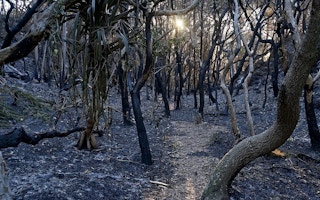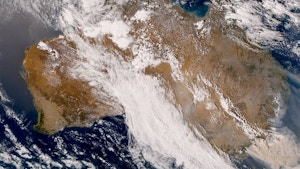Nearly a year after it was declared a global health emergency, Covid-19 has shattered economies, upended countless lives, and killed almost two million people. But as devastating as these disruptions are, the impacts of climate change are set to be deadlier.
To continue reading, subscribe to Eco‑Business.
There's something for everyone. We offer a range of subscription plans.
- Access our stories and receive our Insights Weekly newsletter with the free EB Member plan.
- Unlock unlimited access to our content and archive with EB Circle.
- Publish your content with EB Premium.
And yet, the climate crisis has not generated a global response as radical as that to the pandemic, raising a critical question: If the world has managed to come together to battle a virus, can it inject similar urgency into the fight against the creeping, civilisation-ending threat of global heating?
As coronavirus infection rates continue to climb, so do carbon dioxide levels in the atmosphere, which hit a record high in 2020. Despite progress made since the adoption of the Paris Agreement, the world is now hurtling towards an average temperature rise of 3 degrees Celsius this century.
Here are the scariest climate stories that you might have missed amid this year’s unprecedented news frenzy.
1. Wildfires ravaged Australia and the American West
The beginning of 2020 found Australia in the midst of its worst bushfire season on record, an event now known among Australians as the “black summer”.
Fuelled by searing heat and drought made 30 per cent more likely by climate change, the disastrous blazes ripped through forests and communities, burning an area more than 250 times the size of Singapore.
They claimed at least 34 human lives and killed almost half a billion animals. Scientists worry that entire species could have been wiped out.
Mere months later, a record-breaking heatwave has hit Queensland, reigniting fears of new fires.
In August, much of the American West, too, was battling record-shattering wildfires, with flames raging along the coast of the United States, torching forests 23 times larger than Singapore in California alone.
The fires killed dozens, blanketed cities in a toxic haze, and raised concerns among biologists that vulnerable species may have suffered lasting damage and incinerated ecosystems could fail to rebound in a warming climate, leading to permanent landscape changes.
A 2016 analysis of 45 years of US Forest Service data by news outlet Climate Central showed that wildfires in the region have increased in number and severity over time, with the average annual number of large fires burning each year more than tripling between the 1970s and 2010s.
Scientists have pointed to changing weather patterns as the main cause for the increase. A 2016 study found that man-made heating was mainly responsible for drier forests in the American West. As global warming kicks into higher gear, dry spells are expected to lengthen, hiking fire risk further.
2. Fate of Arctic sea ice likely sealed, even with climate action
In April, scientists were alarmed to discover that the northernmost sea will most likely lose its summer ice cover entirely before mid-century, even if emissions driving global heating are slashed rapidly.
Some studies suggested an even more aggressive timeline, predicting that Arctic ice—which currently covers the North Pole year-round—could disappear for part of the year as early as 2035.
An ice-free Arctic now appears possible even in the dark, cold winter months if emissions remain on their current trajectory, a prospect that scientists said would be “catastrophic” for the fragile region and its wildlife.
Since researchers began keeping records in 1979, summer Arctic ice has lost 40 per cent of its area and up to 70 per cent of its volume. As retreating ice exposes the dark Arctic waters beneath, more of the sun’s heat is absorbed, warming the region faster.
In July, it was revealed that less sea ice covered the Arctic Ocean than in any other July since records began. A month later, the last remaining intact ice shelf in the Canadian Arctic collapsed.
At the end of October—when winter usually returns to the region—scientists said the Laptev sea, the main nursery of Arctic sea ice in Siberia, was not yet freezing at the latest date on record.
While far from Asia’s bustling megacities, experts have warned the Arctic’s disintegration will reverberate across the planet. This is because its sea ice plays a critical role in regulating the Earth’s climate, and its melting threatens to throw global weather patterns and ocean currents off-kilter.
As the Arctic continues to unravel, researchers maintain that carbon cuts remain essential to prevent ice loss from becoming permanent and enable the region to recover over time.
3. Polar bears could be wiped out by 2100
Polar bears have long been the poster child of climate change. This year, scientists predicted for the first time when the Arctic carnivores could go extinct, warning that if carbon emissions continue to rise, all but a few polar bear populations will disappear by 2100.
A study, published in Nature Climate Change, stated that melting Arctic sea ice could cause starvation and reproductive failure among polar bear populations by as early as 2040, leading to local extinctions across North America, Greenland, Norway and Russia.
Under a business-as-usual emissions scenario, polar bears will, by the end of the century, likely only remain in the northernmost cluster of islands of Canada’s Arctic archipelago.
It is estimated that there are fewer than 26,000 polar bears left, and as sea ice continues to decline, so, too, will the bears that depend on sea ice to hunt.
4. Greenland’s ice sheet has possibly melted to point of no return
We know that Greenland’s ice is shrinking fast. The island lost more ice in 2019 than in any year on record, equivalent to a million tonnes per minute across the year.
A paper published this year found the ice sheet is now retreating faster than at any time in the past 12,000 years and may melt entirely if the world keeps burning fossil fuels at current levels, underscoring how the changes triggered by human actions now dwarf many of the ups and downs of the planet’s geologic past.
But here’s what really scared researchers in 2020: An analysis released in August showed the vast ice sheet’s climate-driven decline has passed the point of no return, and efforts to rein in heating will not halt its disintegration. This spells bad news for coastal communities around the world.
Greenland at present sheds more than 280 billion metric tons of melting ice into the ocean each year, making it the largest contributor to global sea-level rise. Should it melt entirely, the ice would push up sea levels by more than 7 metres.
The UN’s Intergovernmental Panel on Climate Change has warned sea levels could rise by almost one metre by the end of the century, flooding major coastal cities like New York and Shanghai, and costing the global economy an estimated US$14.2 trillion in lost or damaged assets.
Not everyone agrees the loss of Greenland’s ice is now irreversible. Scientists have also stressed that human actions can affect how quickly the ice vanishes—which could take centuries—and that rapid emission reductions could give coastal communities more time to adapt.
5. Siberia baked under a record-breaking heatwave
Temperatures of 38 degrees Celsius north of the Arctic Circle were previously unthinkable. The World Meteorological Organization even carried out its own research to verify the new temperature record reported by the Siberian town of Verkhoyansk in June.
Between January and June, temperatures in the far north of Russia soared more than 5 degrees Celsius above average. A report found the record-smashing heatwave was made at least 600 times more likely by human-induced warming.
The heat triggered unprecedented, carbon-spewing wildfires which scorched landscapes that are typically too cold, wet, and icy to burn.
The Arctic is already warming twice as fast as the rest of the world, and experts worry this year’s heat could become a regular occurrence that would cause permafrost to thaw even faster, releasing more methane, an extremely powerful greenhouse gas.
6. Deadly storms ploughed through Vietnam, as China, India, Nepal, Bangladesh and East Africa battled crippling floods
Having largely contained the Covid-19 pandemic, China found itself dealing with the worst flooding in southwest provinces in decades this July as relentless rains lashed the region, killing hundreds and affecting 38 million people.
To the west, torrential rains left about a third of Bangladesh inundated in August, with at least 161 people killed and an estimated 1.5 million displaced. Biblical floods also struck neighbouring India and Nepal, killing hundreds.
Flooding and mudslides are an annual occurrence in South Asia, but experts say global warming is causing their frequency and intensity to increase.
Two months later, four tropical storms—the worst in decades—barrelled through Vietnam in less than three weeks in October, leaving communities little time to recover before being hit again. A total of nine storms battered the climate-vulnerable country.
Hundreds were reported to have died in the storms, with more than 300,000 homes destroyed by flooding. While Vietnam is no stranger to extreme weather, scientists called the back-to-back storms “particularly unusual”.
As the planet warms, experts forecast storms and extreme rainfall to become more intense and frequent, and the annual rainy season to become longer and more erratic.
Meanwhile, an estimated six million people across Ethiopia, Uganda, Kenya and other East African nations were struck by the worst floods in four decades in October, with hundreds reportedly dead and 1.5 million forced to flee as mudslides and rivers bursting their banks swept away their homes.
The floods brought yet another threat, with heavy rainfall following prolonged droughts attracting swarms of locusts, ravenous pests that devour crops, threatening to strain food supplies. Studies have linked a hotter climate to more damaging locust swarms.
7. Even if Paris goals are met, thawing Antarctic ice will raise sea levels by 2.5 metres
Recent climate pledges by major emitters have stirred hope that the world can limit global warming to 2 degrees Celsius. New research, however, shows it is already too late to prevent Antarctic ice from pushing up sea levels by 2.5 metres.
While the ice cap’s shrinking is expected to happen over a longer period beyond 2100, scientists are almost certain the process is now irreversible, and that the ice would not regrow to its initial state due to its accelerating destabilisation.
Satellite images in September showed that two giant Antarctic glaciers were breaking up fast, coming on the heels of a paper that found 60 per cent of Antarctic ice was susceptible to fracture, raising the risk of meltwater flows into crevasses that would speed up the ice sheet’s collapse.
In July, researchers were startled to find that the East Antarctic ice sheet, which holds 80 per cent of the world’s ice, may be even more vulnerable to climate change than previously thought. They discovered that large parts of the ice disintegrated during a relatively mild warm spell 400,000 years ago, when the amount of carbon dioxide in the atmosphere was much lower than today.
If countries fail to meet Paris Agreement commitments, the consequences will be “catastrophic”, scientists say.
It is estimated that if temperatures increase by 4 degrees Celsius above pre-industrial levels, the Antarctic ice sheet alone—which covers an area about the size of North America and is nearly 5 kilometres thick—could raise sea levels by 6.5 metres.
This story is part of our Year in Review series, which journals the stories that shaped the world of sustainability in 2020.














